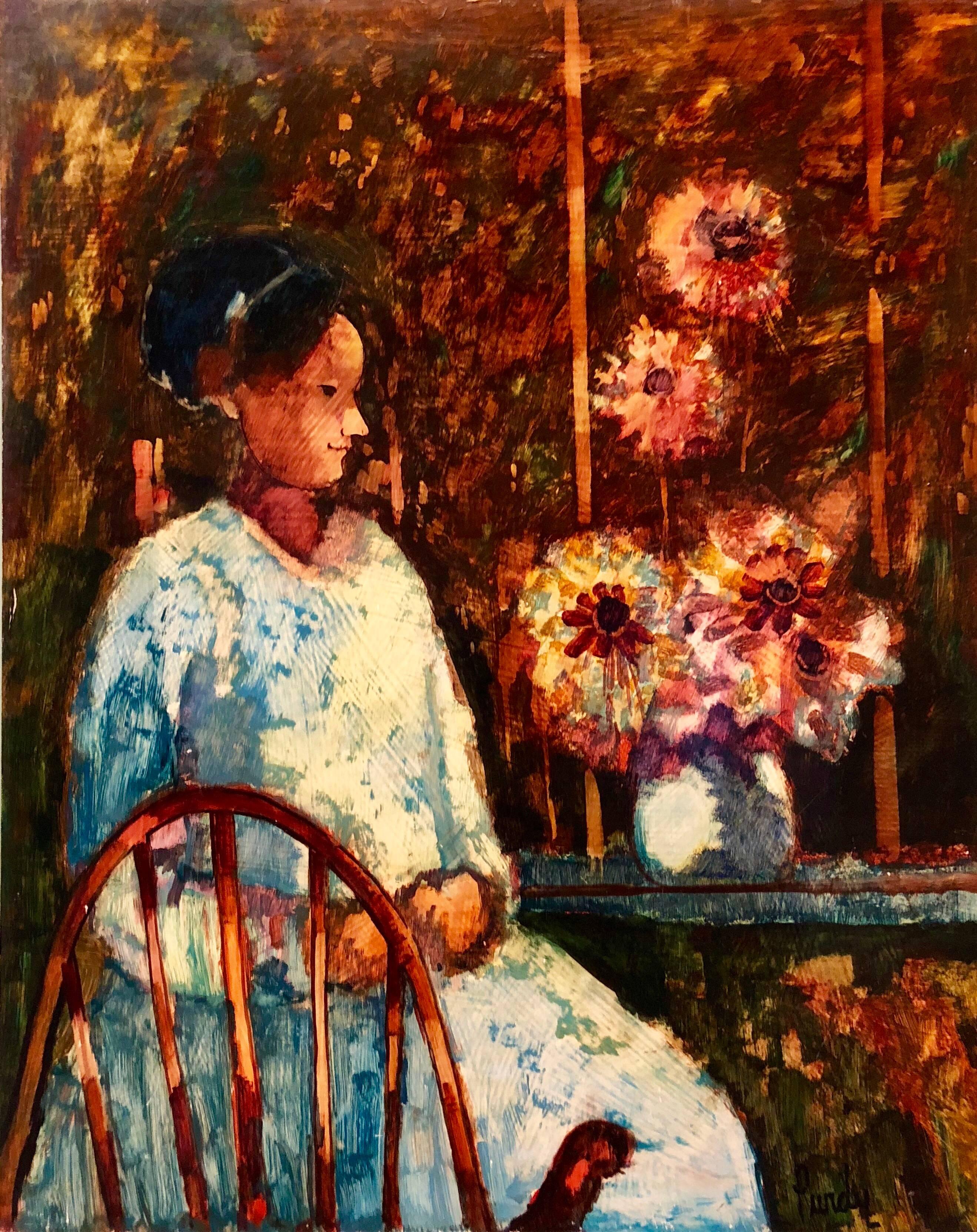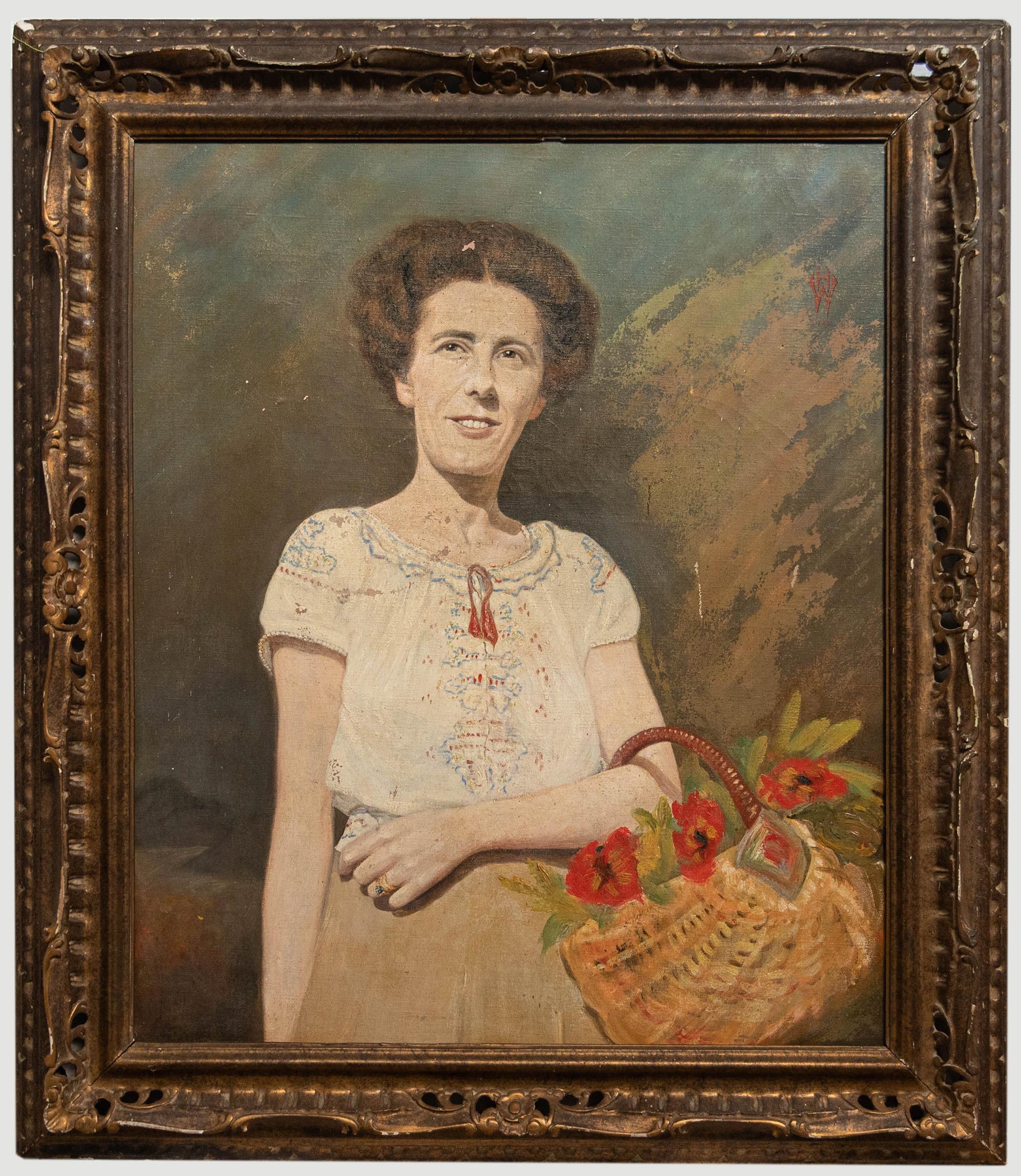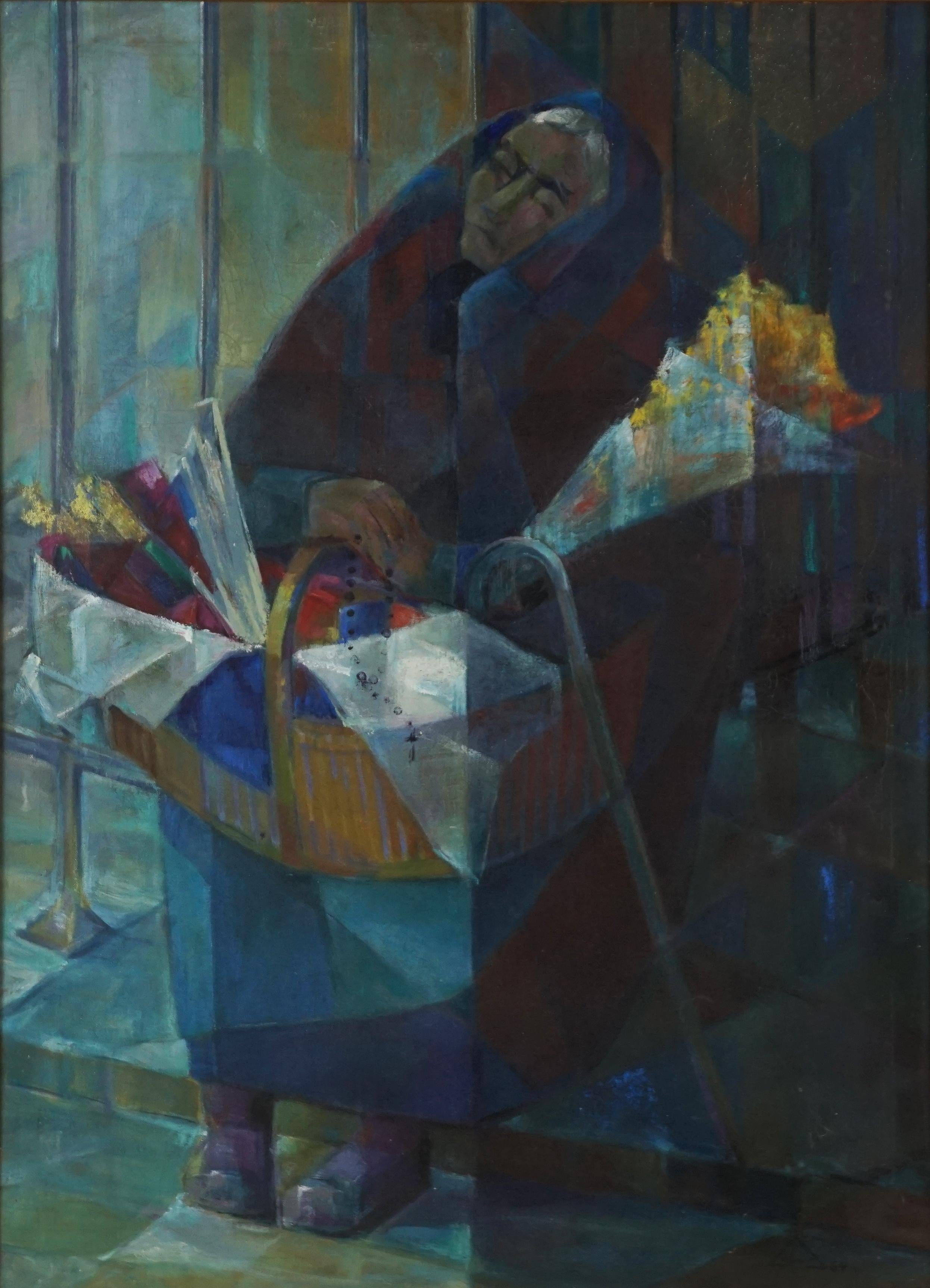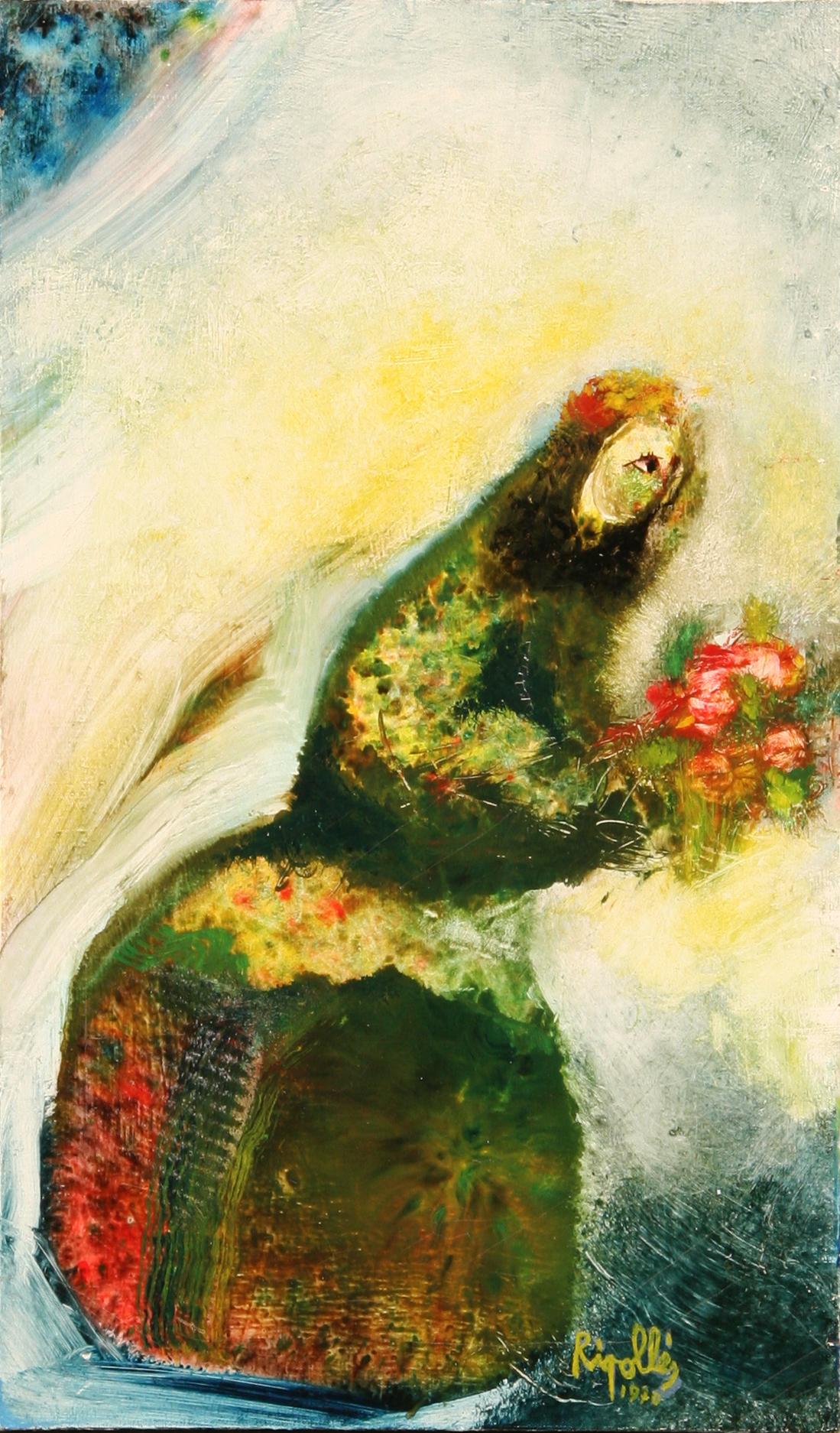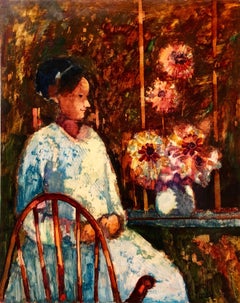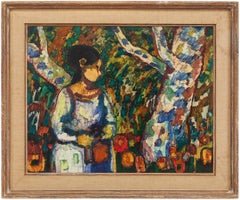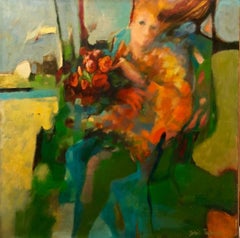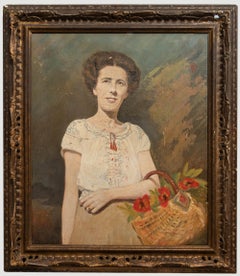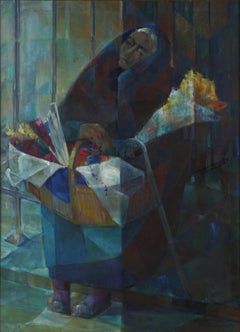Items Similar to Woman in Apron with Basket of Flowers, Oil Painting
Want more images or videos?
Request additional images or videos from the seller
1 of 8
Mildred BarrettWoman in Apron with Basket of Flowers, Oil Painting
$850
£645.31
€738.09
CA$1,187.57
A$1,320.84
CHF 689.70
MX$16,073.23
NOK 8,808.55
SEK 8,260.86
DKK 5,508.66
Shipping
Retrieving quote...The 1stDibs Promise:
Authenticity Guarantee,
Money-Back Guarantee,
24-Hour Cancellation
About the Item
Manhattan-born Mildred Barrett is a woman to whom painting is capturing the mood of the subject with an exceptional use of color.
Barrett's training includes the Art Students League, the National Academy of Fine Arts, and the Brooklyn Museum Art School. She has traveled extensively through which the theme and style of her work was created and developed.
Barrett has had numerous one-woman shows on Madison Avenue in New York and in galleries on Long Island and her works have been sold and re collected all over the United States, Canada, and Europe. Her paintings are also on permanent display at Bergdorf Goodmans Nenas Choice Gallery. There is a simplicity and charm in Barretts work which is enhanced by her remarkable feeling for color. Her impressionistic style captures the mood of the subject - figures which are unique in themselves in certain poses and expressions. Her canvases glow with flowers which look as though they have just been picked.
Barrett is considered one of the finest female artists, certainly, living in the United States today.
- Creator:Mildred Barrett (American)
- Dimensions:Height: 17.5 in (44.45 cm)Width: 13.5 in (34.29 cm)
- Medium:
- Movement & Style:
- Period:
- Condition:original frame has slight wear.
- Gallery Location:Surfside, FL
- Reference Number:1stDibs: LU38211766282
About the Seller
4.9
Platinum Seller
Premium sellers with a 4.7+ rating and 24-hour response times
Established in 1995
1stDibs seller since 2014
1,784 sales on 1stDibs
Typical response time: <1 hour
- ShippingRetrieving quote...Shipping from: Surfside, FL
- Return Policy
Authenticity Guarantee
In the unlikely event there’s an issue with an item’s authenticity, contact us within 1 year for a full refund. DetailsMoney-Back Guarantee
If your item is not as described, is damaged in transit, or does not arrive, contact us within 7 days for a full refund. Details24-Hour Cancellation
You have a 24-hour grace period in which to reconsider your purchase, with no questions asked.Vetted Professional Sellers
Our world-class sellers must adhere to strict standards for service and quality, maintaining the integrity of our listings.Price-Match Guarantee
If you find that a seller listed the same item for a lower price elsewhere, we’ll match it.Trusted Global Delivery
Our best-in-class carrier network provides specialized shipping options worldwide, including custom delivery.More From This Seller
View AllModernist SUNDAY MORNING HARVEST Woman with Flowers Oil Painting
By Donald Roy Purdy
Located in Surfside, FL
Genre: Modern
Subject: Figures
Medium: Oil
Surface: Board
Country: United States
signed lower left
Donald Roy Purdy is an American painter whose work evolved through a range of styl...
Category
20th Century Fauvist Figurative Paintings
Materials
Oil, Board
Modernist Woman With Flowers in Interior
By Donald Roy Purdy
Located in Surfside, FL
Genre: Impressionist
Subject: Still Life
Medium: Oil
Surface: Board
Country: United States
Dimensions: 24.75 x 36
Donald Roy Purdy is an American painter whose work evolved through ...
Category
20th Century Impressionist Figurative Paintings
Materials
Oil, Board
Modernist Woman With Flowers in Forest
By Donald Roy Purdy
Located in Surfside, FL
Genre: Modern
Subject: Figures
Medium: Oil
Surface: Board
Country: United States
Dimensions w/Frame: 31 x 37
Donald Roy Purdy is an American painter whose work evolved through a ran...
Category
20th Century Fauvist Figurative Paintings
Materials
Oil, Board
Autumn Wind, Large American Modernist Oil Painting Woman with Flowers
By Doris Turner
Located in Surfside, FL
Nice American Modernist Oil Painting. with old label verso. not dated but estimating it to the 70s. Not sure which Doris turner this is...
Category
1970s American Modern Figurative Paintings
Materials
Canvas, Oil
Girl & Plants Enamel Glazed Ceramic Plaque Israeli Artist Awret Naive Folk Art
By Irene Awret
Located in Surfside, FL
This is a rare ceramic plaque painted with enamel glaze by famed Israeli German artist Irene Awret (these are generally hand signed Awret Safed on the verso. I just have not opened the frame to check) the actual glazed ceramic is 10.25 X 14.75 inches.
It depicts a girl or woman with potted plants, birds, pomegranates and other fruits and flowers in a naif, folk art style.
Irène Awret was born to a Jewish family in Berlin called Spicker, the youngest of three children. Her mother died in 1927, when Irène was six years old. In 1937 she was forced to stop high school, due to the Nazi race laws. Because she could not continue her regular studies, her father sent her to study drawing, painting and art restoration with a Jewish painter. Among his students were a large number of German Jews who knew they would have to leave Germany within a short time and would require a profession to enable them to support themselves.
When the situation grew worse, following the Kristallnacht (the first major attack on German and Austrian Jews in November 1938), her uncle decided to move to Belgium. In 1939 the situation became even worse - her father was fired from his job and the family were forced to leave their home. As a result, Awret's father tried to send her and her sister to Belgium, with the help of smugglers. The first smuggler proved to be a double agent and they were sent back from Aachen to Berlin. Two weeks later they made a second, successful, attempt to sneak across the border.
Awret worked for a Dutch Jewish family as a maid. As she had her room and board there, she was able to save enough money to study art part-time at Brussels' Académie Royal des Beaux-Arts. A few months later Awret's father joined her and her financial situation became easier. She left her job and studied full-time, helping support herself with restoration work when it was available and by painting portraits to order.
Later, Awret found a hiding place on a farm in Waterloo with a Jewish family who were connected with the underground. In January 1943 she had to return to Brussels, living with a false identity card which stated she was a married woman with two children. Awret succeeded in renting an attic without informing the police where she was - she told her landlady that she had been forced to flee her husband because he beat her. While there, she supported herself by restoring wooden sculptures.
A Jewish informer gave her up to the Gestapo, accompanying the two Gestapo men who arrested her. Awret was able to take a bag containing food and drawing materials. She was detained in the Gestapo cellars in Brussels where she drew. Because there was nothing there to draw, she sketched her own hand (view this work). Awret was interrogated in order to reveal the hiding place of her father who was still in Brussels. The National Socialist regime was determined to persecute him, even though he had fought for Germany in World War I and been permanently disabled. They stepped up their torture and brought Awret before Hartmann, the head of the Gestapo in Brussels. When Hartmann saw her block of drawings, he asked her where she had studied art and halted the interrogation.
Awret was placed in a narrow cell and then transferred to Malines camp, which the Belgian's called Mechelen. Malines was a transit camp to Auschwitz, regularly sending 2000 people at a time. Although she arrived just before Transport No. 20, Irène Awret avoided being included. Instead she was put to work in the leather workshop, decorating broaches. While she was there, Hartmann visited the camp and spotted her: "I could have discovered where your father is hiding," he told her. When her artistic talents became known, she was transferred to the Mahlerstube (artist's workshop) where she worked producing graphics for the Germans until the end of the war. When Carol (Karel) Deutsch (whose works are now on view at Yad Vashem) was sent from Mechelen to his death with his wife, he left young Irene his paintbox. Irene also recalls seeing the great painter Felix Nussbaum and his wife being pushed into a boxcar bound for the gas, and tells of the aftermath of the famous 20th Train incident, when a young Jewish doctor armed only with a pistol and helped by two unarmed friends with a lantern ambushed one of Mechelen's Auschwitz-bound trains carrying 1,618 Jews, most of whom had fled Eastern Europe for Belgium.
Awret's job enabled her to paint and draw - mainly in pencil, but also in watercolors and oils. In the artists' workshop she met a Jewish refugee from Poland - Azriel Awret - who would later become her husband. Among the other artists in the workshop were Herbert von Ledermann-Vütemberg, a sculptor from an aristocratic family with Jewish roots, Léon Landau, and Smilowitz, who perished in the camps in the East. Irène and Azriel tried to bribe a German officer to prevent Smilowitz's deportation. Not only were they unsuccessful, but they were almost put onto the same train. Jacques Ochs was another artist with whom they became friends in the camp. Ochs, a French-born Protestant who lived in Belgium, was interned as a political prisoner. He remained in Belgium after liberation.
After the war the Awrets immigrated to Israel and made their home in Safed. They continued to work, and were instrumental in founding Safed's artists' quarter.
The Beit Lohamei Haghetaot (Ghetto Fighters' House Museum) art collection holds works donated by Awret. These date from her time in Malines camp and from her stay in Brussels after the war, when she was in the company of orphans who had hidden while their parents were sent to Auschwitz. Her highly expressive works have made their way to exhibitions at theTel Aviv Museum, the Haifa Museum of Modern Art and the Modern Art Gallery in Washington, D.C., as well as into the private collections of such individuals as Dr. Jonas Salk...
Category
1950s Expressionist Figurative Paintings
Materials
Enamel
The Happy Inlaw, Oil Painting
By Maurice Kish
Located in Surfside, FL
The imagery of Maurice Kish (1895-1987), whether factories or carousels, reliably subverts expectations. His vision hovers just around the unraveling edge of things, where what is solid and clear becomes ambiguous. He is fascinated, often delighted, by the falling apart. This unexpected, fresh perspective results in oddly affecting pictures of a now long-gone New York.
Born Moishe in a town called Dvinsk, Russia (what is now Daugavpils, Latvia), Kish came with his family to New York when he was in his teens. The family settled in Brownsville, and for the rest of Kish’s life Brooklyn remained his home, though he moved from one neighborhood to another. He was close to his parents, who recognized his talent and supported his desire to become an artist.
Kish attended the National Academy of Design as well as Cooper Union. His fellow students included many other immigrants and children of immigrants who were particularly receptive to the Modernism coming from Europe. As his career progressed, Kish himself applied different strains of Modernism to different purposes. For him, the story was held above all else.
For years, Kish used the skills he acquired in art school to earn his living at a Manhattan glass...
Category
20th Century Folk Art Figurative Paintings
Materials
Oil, Board
You May Also Like
Girl with a Flower Basket, Impressionist Oil Painting by Philippe Alfieri
By Philippe Alfieri
Located in Long Island City, NY
Artist: Philippe Alfieri, Italian/American (1921 - 2009)
Title: Woman with Flower Basket
Year: circa 1970
Medium: Oil on Canvas, signed l.l.
S...
Category
1970s Modern Portrait Paintings
Materials
Canvas, Oil
H. W. - 1947 Oil For Restoration, Lady with the Flower Basket
Located in Corsham, GB
Signed with a monogram and dated to the upper left. Presented in a gilt frame with pierced details. On canvas.
Category
Mid-20th Century Portrait Paintings
Materials
Oil
$293 Sale Price
20% Off
Mid Century Cubist Oil Painting of Woman with Flowers in Style of Jacques Villon
Located in Soquel, CA
Wonderful mid century cubist figurative of older woman with flowers and basket in style of Jacques Villon (French, 1875 - 1963). Signature (Possibly "Louyot") and dated "1964" lower right corner. Presented in original, gilt-toned painted frame (included as-is). Image size: 36"H x 25"W
An early 1900s modern art movement, Cubism focused on exploring relationships between images, perspectives and materials, and opened the door to Abstraction. Cubism began in Paris with Pablo Picasso and Georges Braque. The term 'Cubist' was a derisive description by a critic of a geometric landscape painting done by Braque in 1908. Juan Gris, the originator of Collage, joined Picasso and Braque in 1910. Originating influences on Cubism included geometric-shaped paintings of Paul Cezanne, Post-Impressionisms’ emphasis on flat picture surfaces, and Picasso's fascination with the abstraction he perceived in African tribal masks. Aspects of Cubism were Analytical Cubism and Synthetic Cubism (see Glossary). By 1914, the Cubist movement as an organizing force officially terminated with the beginning of World War I. But its effects remain today. "Almost all later art, figurative and abstract, two and three-dimensional, random or hieratic, was conditioned in some way by these new dimensions of reality." (Phaidon) Other French artists associated with Cubism concepts were Fernand Leger, Marcel Duchamp and Nicholas Delauney. In America, leading Cubist painters...
Category
1960s Cubist Figurative Paintings
Materials
Linen, Oil
Woman with Flowers, Watercolor Folk Art by Jovan Obican
By Jovan Obican
Located in Long Island City, NY
Woman with Flowers
Jovan Obican
French/Yugoslavian (1918–1986)
Date: circa 1980
Watercolor on Paper
Size: 27.5 x 19 in. (69.85 x 48.26 cm)
Frame Size: 30.5 x 22.5 inches
Category
1980s Folk Art Drawings and Watercolor Paintings
Materials
Watercolor
Woman with Flowers III, Oil Painting by Juan Garcia Ripolles
By Juan García Ripollés
Located in Long Island City, NY
Artist: Juan Garcia Ripolles, Spanish (1932 - )
Title: Woman with Flowers III
Year: 1970
Medium: Oil on Canvas, signed l.r.
Size: 18 in. x 10.5 in. (45.72 cm x 26.67 cm)
Category
1970s Expressionist Figurative Paintings
Materials
Oil
Woman with Basket of Wildflowers
Located in Genève, GE
Work on canvas
Golden wooden frame
63 x 88 x 3.5 cm
Category
Early 20th Century French School Landscape Paintings
Materials
Oil
More Ways To Browse
Vintage Aprons
Basket Flower Painting
Vintage Bergdorf Goodman
Madison Avenue Art
Bergdorf Goodman Display
Barrett Oil Painting
1950s Portrait Oil Paintings
Spanish Village Painting
Vintage Cafe Sign
Figurative Crowd Paintings
Seen Graffiti
Paintings By Garcia
Oil Painting Man 19th Century
Mother And Child Oil Paintings
88 Gallery
Paintings Of Istanbul
Russian Paintings Soviet
Peasant Painting
